A couple of weeks ago, I posted about my son’s battle and recovery from an infectious disease known as Kawasaki.
I am happy to report he is back in school and is happy and energetic. He has made a great recovery with no apparent after-effects.
In addition to the amazing support of our friends, church and community, I was astounded at the phenomenal care he received from his nurses, techs, doctors, and interns.
They were an excellent example of teamwork. In fact, their actions could apply to anyone interested in growing as a team, organization or even as a family.
So here a four lessons in teamwork I have been reflecting on from our experience with my son’s medical team:
1. A common goal unites a group of diverse people.
To give you some context, when our son was first admitted, he was in terrible shape: high fever, rash, swelling, etc. When they diagnosed him with Kawasaki and began treatments, his condition worsened.
Then he went into shock.
His treatments had to stop while they stabilized him for the next twenty four hours. Then they began treatments again, and this time the symptoms began to disappear and he began to heal.
It was obvious during the entire time that his medical team had one goal in mind: to save our son.
No matter their backgrounds, gender, differences in job titles or compensation, each team member was focused on that one outcome. Every decision was weighed against its effect on him, his condition, and well-being.
In Jim Collin’s book, Good to Great, he studies the most effective businesses in America–ones with the longest track record of success.
And one of many contributing factors was the ability of great companies to focus on a specific area where they can be most effective and work toward that goal.
Lesson learned? When we focus on a common goal, not allowing ourselves to be distracted by secondary ones, we are more strategic and effective. What is the common goal you are working toward with your team? A common goal can unify the most diverse of people into positive action.
2. Great team members know their roles and execute them well.
Whether it was the nurse tech assigned to check my son’s vitals, his RN who was determined to bring his fever under control, his physicians prescribing treatments or the pharmacists or lab techs we never met but who were prescribing or analyzing–each one played a pivotal role in his healing.
And each one performed the role assigned. The nurse did not attempt diagnose. That was the doctor’s role. The tech did not administer meds. That was the nurse’s role. Instead, each person performed the role he or she had been assigned.
At an athletic event, you sometimes see a team playing “in the zone”. Everything seems to flow effortlessly. But in reality you are observing the skills of individuals who understand their roles and have played them long enough, practiced enough, and been together enough to make a complicated event look like play.
The result is something beautiful to observe.
Lesson learned? Fulfilling specific roles means each team member understands his or her key responsibility areas. When each of us performs our specific role on a team, the effect and outcome can often be breath-taking.
3. Caring for people and reaching outcomes must go hand in hand.
Not only did his medical team accomplish the goal of curing our son, but also they truly cared for him.
Whether it was regulating his meds, whispering soothing words, or finding creative ways to relieve fever, they were consistently showing the sincerest care for him.
Most educators are familiar with the research done by the Gates Foundation on the three R’s that are present in all great schools: rigor, relevance, and relationship.
In school, an educator may be an expert in curriculum and instruction. But the intangible element of caring for and loving students always separates a good “instructor” from a great “teacher”.
Lesson learned? When trust and care are present, not only is a goal accomplished but a meaningful relationship is established at the same time. And usually more learning, productivity and positive outcomes occur in the process.
4. Great teams remain teach-able.
Another of the reason I think my son’s medical team was so effective was that he was in a teaching hospital. Resident doctors interning there were being asked to participate and lead in decision making. At the same time, the older doctors were mentoring, coaching, and teaching them.
It was an atmosphere of mutual respect where continuous learning, research, and practice were valued.
Not only do you flourish when you work in a culture of learning but also those whom you are serving will flourish too.
Lesson learned? When people value the importance of constantly learning from one another, relying on research-based methodology, and growing through experienced practice, then you have created a culture of learning and growth.
Great things happen in places where people are flexible, open, and teachable.
Conclusion:
Great teams work for common goals, execute individual roles, care for others, and remain teach-able. In my son’s case, the actions of a great team quite literally saved his life. Think about what we can accomplish in our lives, schools or organizations when we do the same.
Now It’s Your Turn:
What are some other examples of great teamwork you have observed? What would you add to the list of qualities it takes to build a great team? What are some resources on team-work that you recommend? Share with the rest of us!
Subscribe For More
Have you subscribed to receive weekly posts from WilliamDParker.com? Visit here for information on how you can sign up.




